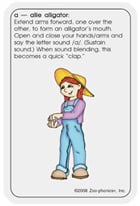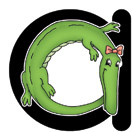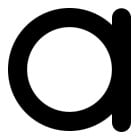 Activities for Animal Picture Cards
Activities for Animal Picture Cards
(Set #1, yellow borders)
Once your child is on the road to learning the Shapes, Sounds and Signals for the Animal Picture Cards, try the following activities. Remember to keep the activities age-appropriate.
Talk About How the Animals Are Shaped Like Letters
Using the Animal Alphabet Cards (Yellow borders), talk about sounds, letters and words. Discuss why letters and letter sounds are needed. Without them, could we read road signs? Department store signs? Could we read a book? Write a letter? Now, tell your child that her/his Animal friends are in the shape of letters. Have your child trace her/his finger along the shape of the Animals. See? They really are letters: Animal Letters! (If you’d like, you could match the Merged Animal/Letters (Set #2, orange borders) with the Animal Pictures to show her/him the letters that are under the pictures.
Play “Follow the Leader.”
Mix up the Animal Picture Cards, and then hold them up one at a time for your child to see. Lead your child around the room or outdoors Signaling the Animal that is shown on the Card. You can hop, run, sing or serpentine as you Signal. You and your child can take turns being the leader. You can play marching music or the music from the Zoo-phonics® Music That Teaches CD, This is a good activity because it allows for large motor movement and full body coordination. It also develops “following directions” skills. Make sure your child Signals and Sounds as s/he moves.
Have an Animal Hunt
Hide the Animal Picture Cards around the room, and then hunt for them. When your child has found all 26 Cards, put them in alphabetical order as you sing or recite the “Jump Rope Rap” from the Zoo-phonics® Music That Teaches CD. (You can find the words to the “Jump Rope Rap” in the Lyric Book enclosed with the CD.)
Ask, “Can You Give Sound and Signal?”
When s/he has mastered all of the Shapes, Sounds and Signals of the alphabet, mix up the Cards. Point to one and ask, “Can you give Sound and Signal for this Animal?” Was your child able to Sound and Signal alone? If not, give help as needed. Remember, however, that children must first learn the alphabet as a whole and in order, since it is a necessary skill for alphabetizing later.
If you have purchased the Music that Teaches CD you can also…
Play the song “It Sounds Like This and It Looks Like That”
Hold up the Animal Picture Cards. This song actually tells the child how to Signal and what Sound to make. As the song progresses, change the Card to fit the Sound and Signal that is being described in the song. You and your child should Sound and Signal as the song progresses. The lyrics are in the CD jewel case.
Play the song “Come Meet Us At the Zoo”
Children enjoy moving to the music. As the Animals are mentioned in the song, your child can “Signal” as many as s/he is able, eventually doing all of them. You can call out the Animal just seconds before the song calls its name. Signal with your child (see lyric booklet in CD case).
Play the “Jump Rope Rap”
When your students know their Sounds and Signals, play “The Jump Rope Rap.” Hold up the Cards while your child jumps in place, jumps rope, or jumps on a mini-trampoline. The matching of one “letter” to each rhyming couplet is a great way to reinforce letter sounds and shapes and have fun at the same time! This is even more fun if Mom and/or Dad and other family members take a turn. In time, match the various Card Sets to this song. While you are at it, have your child learn the words to the song. Listen for the rhymes in each couplet.
 Activities for the Body Signals
Activities for the Body Signals
Listen For Initial Sounds in Names and Words
Call out a Consonant-Vowel-Consonant (CVC) name. Example: “Pam.” Have your child listen to the initial sound found in this name, and then s/he will give Sound and Signal (“sam,” “pat,” “bob,” “tim,” “pam,” “kim,” “ed,” rob,” “ben,” “dan,” “kit,” “jen,” “ted,” “ned,” “gil,” “meg,” “lin,” “peg” etc.). Try this activity with CVC words (bat, cat, dog, man, ran, kid, pit, etc.
Variation: As you read a book, point to certain pictures and ask something like this, “In the word ‘box,’ what is the first sound you hear?” Wait for your child’s response. If help is needed, Sound and Signal together, stressing the “b” sound in “box.”
Give the Signal for the Initial Letters as You Read
Sing a favorite song or recite a nursery rhyme. Give the Signal for the initial letters in the key words. (The initial letters are underlined in the song below.) Do not Signal the more advanced sounds that you have not taught as yet (I, what, are, etc.) Just drop your hands as you sing or recite.
Toss a Beanbag
Give an Animal Name as you toss a beanbag (or toss or roll a ball). Your child will catch the beanbag and then give Sound and Signal for the Animal. The child then gives an Animal Name and tosses the beanbag back to you, or to someone else. Continue through the Animal alphabet. This is a good game for the whole family to play.
Play “Zoophonia May I?” (Plays like “Mother, May I?”)
Mix up the Animal Picture Cards and put them in a stack, face down. Place ten slips of paper in a bowl, numbered from 1 to 10. The child says, “Zoophonia, May I come to visit you?” Zoophonia turns up one Card and takes one number from the number bowl, and her reply would combine the selected Animal and number such as, “Yes, you may take five Ellie Elephant steps.” The child moves like Ellie and takes five large elephant steps. This will reinforce counting as well. This is a great activity to teach your child how to use the phrase, “May I…”
Play “Zoophonia Says” (Plays like “Simon Says”)
Have your child stand in front of you so you can see her/him, about three to five feet away. (Sitting at a table is fine too.) Call out the names of the various Animal Characters out of sequence, such as: “Zoophonia says, ‘Do Queeny Quail.’” The child responds with the appropriate Sound and Signal. Call out, “Zoophonia says, ‘Do Lizzy Lizard’.” The child responds. Call out, “Do Missy Mouse.” If s/he responds with a Sound and Signal when you omit the words “Zoophonia says,” s/he is in the “mush pot,” or is “out.” You can start a new game. If you have more than one child playing, s/he can sit down while the game continues. You can give your child many chances before putting her/him in the mush pot. This is a great “I can follow directions” activity.
 Activities for Merged Animal/Letter Cards
Activities for Merged Animal/Letter Cards
(and products that have the Merged Animal Letters on them)
Ask, “Which Animal is this?”
Show the Merged Animal/Letter Cards, one at a time, from“a – z.” Ask, “Which Animal is this?” The child gives the Animal Name and then Sound and Signal (ellie elephant, “e¢”).
Ask, “Where does this Card belong?”
This is a Matching Game. Lay out the Animal Picture Cards (Set #1) from “a – z.” Now, take the Merged Animal/ Letter Cards (Set #2). Hand them to your child, one at a time, and say, “Where does this Card belong?” S/he will match it to the Animal Picture Card. Sound and Signal together. Do this for several days before allowing her/him to match on her/his own. You are helping her/him to make the transition from Animal Pictures to Merged Animal/Letters.
Flash These Cards!
Once your child recognizes each one, use either the Animal Picture Cards or the Merged Animal/Letter Cards as flash cards. Go from “a – z.” Your child will respond with the Animal Name and Sound and Signal (allie alligator, ‘a¢’). Don’t forget to Signal and Sound. This activity will teach your child to quickly say the sounds as s/he sees the letters.
Play an Auditory Game
This next game is a visual and auditory game. Lay out three Merged Animal Letter Cards. Call out the sound of one of the Cards. Your child will hold up the appropriate Merged Animal Letter. When your child can choose one out of three correctly, add another card.
Add to the challenge. Once s/he is confident and is doing this activity successfully, say “I will say a word, and I want you to find the Card that matches the first sound of that word.” Choose simple words: in, at, up, on, is, dad, mom, big, dig, sit, box, fog, etc. Example: call out “cat.” The child will hold up the Merged “Catina Cat” Card, and give Sound and Signal. Practice this often.
Ask, “What is this?”
Display the Merged Animal/Letter Cards, “a – z.” Show your child a picture of an object (car, house, man, etc.). Say, “What is this?” When your child responds by naming the object, then ask, “What Animal/Letter do you hear at the beginning of that word?” The child will hold up, or point to, the correct Card. You can cut pictures out of magazines and catalogs. You might even want to laminate them and place them in envelopes or a small plastic box for safekeeping.
Variation: Display the Merged Animal/Letter Cards, “a – z.” Ask your child the names of objects in your home as you point to them. As the child says “door,” ask her/him to hold up, or point to, the corresponding Merged Animal Letter Card. Always Sound and Signal.
NOTE: Please don’t rush any of the stages. If your child shows signs of stress or disinterest, go back to where s/he was happy and successful. You have plenty of time to teach these skills. Remember, “Keep it light and make it fun,” and they’ll keep coming back for more!
 Lower Case Letter Cards
Lower Case Letter Cards
(Set #2, Reverse Side of Merged)
If your child has gone through the sequence of the Introduction of the Animals, the Animal Picture Cards and the Merged Animal/Letter Cards, it may be time to introduce the Lowercase Letters. Try one or two Activities. If you find them too difficult, go back to “safer waters” — the Merged Animal/Letters. It is important to always keep the association with the Animals.
As you are making the transition from the Animal Pictures to Merged Animal/Letters to Lowercase Letters, keep reminding the child that all three sets are letters. See if they can find their Animal Letter friends in books, magazines and newspapers. Your child must make the connection between the Merged Animal Letters and the Letters found in words.
We recommend that you NOT introduce this set until the Animal Picture Cards and the Merged Animal/ Letters have been mastered. When you determine that your child is ready, start making the transition into the plain letters by matching the Merged Animal Letters with the Letters. The Letter Cards are more advanced for toddlers, three- and four-year-olds. They will learn them quickly, however, if you carefully lay the alphabet foundation the Zoo-way!
Activities for Letter Cards
Match to Animal Picture Cards
Place the Animal Picture Cards on the carpet from “a – z.” Hand out the Lowercase Letters, one at a time, and have the child match them, Sound and Signal. Now match the Merged Animal/Letters to those matches. This is a great “self check.”
Ask, “What Sound Does This Make?”
Hold up the Letter Cards, one at a time. Ask, “What sound does this letter make?” Your child is to Signal and make the letter’s sound. Start connecting these letters to text as you read. Have Cards handy. Address initial sounds. Spell out VC/CVC words. (Vowel/Consonant, Consonant/Vowel/Consonant. See glossary in the back of this booklet.) Remember, try this only after the Animal Pictures and Merged Animal Letters have been MASTERED!
Tie Letters to Games and Text
From now on, every time you play Zoo-games, activities or read books, tie the Letter Cards to the initial sounds (or ending or middle sounds). Any time you use your Animal Letter Cards or Merged Animal/Letter Cards, include the Letter Cards as support. This will help your child make the transition into letters. Letters are what s/he will see in text from now on!
Teach the Letter Names
(Prerequisite: your child must know all the Sounds for each letter.)
As your child masters the sounds of the alphabet, perhaps it is time to learn the letter names. Sing the ABC Song and Signal it out, but instead of calling out the Sounds, call out the letter names. You can “flash” the Animal Letter Cards as you sing (in order!).
Spell Out Words
When your students are ready, spell out simple words with the Letter Cards. Again, only after you have practiced this activity with the Animal Picture Cards and then the Merged Animal/Letter Cards. Sound and Signal!
